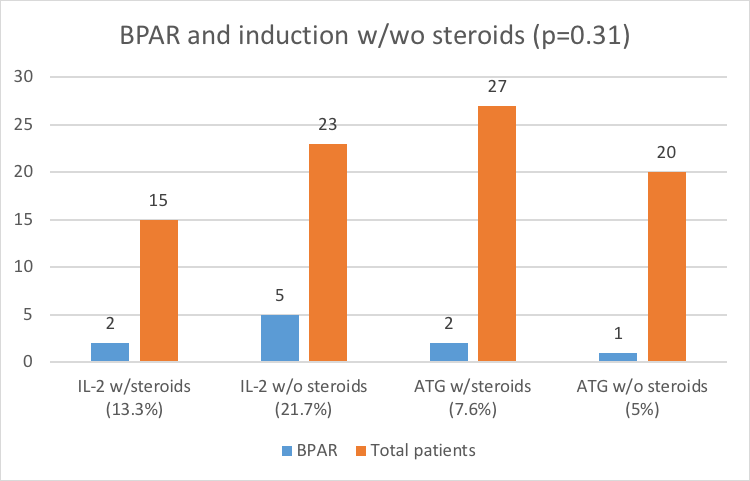Early Rejection Outcomes with IL-2 vs. ATG Induction among Kidney Transplant Recipients Induction Differences with Early Steroid Withdrawal
University Hospitals Cleveland Medical Center, Cleveland, OH
Meeting: 2019 American Transplant Congress
Abstract number: A274
Keywords: Immunosuppression, Induction therapy, Kidney transplantation, Rejection
Session Information
Session Name: Poster Session A: Kidney Immunosuppression: Novel Regimens and Drug Minimization
Session Type: Poster Session
Date: Saturday, June 1, 2019
Session Time: 5:30pm-7:30pm
 Presentation Time: 5:30pm-7:30pm
Presentation Time: 5:30pm-7:30pm
Location: Hall C & D
*Purpose: Early steroid withdrawal in kidney transplant (Ktx) patients is controversial and has demonstrated an increased risk of acute rejection with similar long-term outcomes. Data assessing impact of induction agents on the risk of biopsy proven acute rejection (BPAR) in this setting are conflicting. As part of a quality initiative, we standardized our induction protocol (Table). We compared the risk of early BPAR among Ktx patients receiving induction with basiliximab (IL-2) vs. antithymocyte globulin (ATG) with and without steroids.
*Methods: Adult Ktx between 11/1/2017 and 10/31/2018 were included in this single-center, prospective cohort study. Primary outcome was incidence of BPAR at 1 month post-tx. Secondary outcomes included incidence of delayed graft function (DGF), cytomegalovirus (CMV) infection, and BK viremia over an average follow-up period of 6 months. Chi-square and logistic regression analyses were performed.
*Results: Of 86 Ktx performed, 38 patients received IL-2 induction, 48 patients received ATG. Steroids were withdrawn in 23 IL-2 patients and 20 ATG patients ATG. There was no statistically significant difference in the incidence of 1 month BPAR between patients receiving IL-2 or ATG with or without steroids (Figure). In multivariate logistic regression analysis; type of induction agent, steroid continuation, or FK levels at various time points were not predictive of 1 month BPAR. Rates of DGF (31.6% vs. 27.7%; p=0.81), CMV infection (2.6% vs. 10.6%; p=0.22), and BK viremia (7.9% vs. 14.9%; p=0.50) were not significantly different between IL-2 and ATG cohorts. During follow-up, in the entire cohort, there was 1 graft loss (technical) and 1 patient death (malignancy; ATG group).
*Conclusions: There was a trend towards a higher BPAR rate in the IL-2 cohort, particularly among IL-2 patients with steroid withdrawal. Although not statistically significant, due to small sample size, these differences may be clinically significant. Further investigation with larger studies is warranted.
|
IL-2 If all are true: |
ATG If any are true: |
Steroid Continuation If any are true: |
| 1st tx | Re-tx | On steroids at time of tx |
| Age ≥50 | Age <50 | Re-tx |
| PRA <80% | PRA ≥80% | PRA >80% |
| KDPI ≤85% | KDPI >85% | Lupus, IGA Nephropathy, FSGS |
| – Xm | + Xm | DGF |
| Pediatric en bloc |
To cite this abstract in AMA style:
Burelli C, Szczepanik A, Yadav K, Sanchez E, Debroy M, Humphreville V, Rabets J, Padiyar A, Sarabu N, Jittirat A, Palanisamy A, Chavin K. Early Rejection Outcomes with IL-2 vs. ATG Induction among Kidney Transplant Recipients Induction Differences with Early Steroid Withdrawal [abstract]. Am J Transplant. 2019; 19 (suppl 3). https://atcmeetingabstracts.com/abstract/early-rejection-outcomes-with-il-2-vs-atg-induction-among-kidney-transplant-recipients-induction-differences-with-early-steroid-withdrawal/. Accessed December 26, 2025.« Back to 2019 American Transplant Congress

